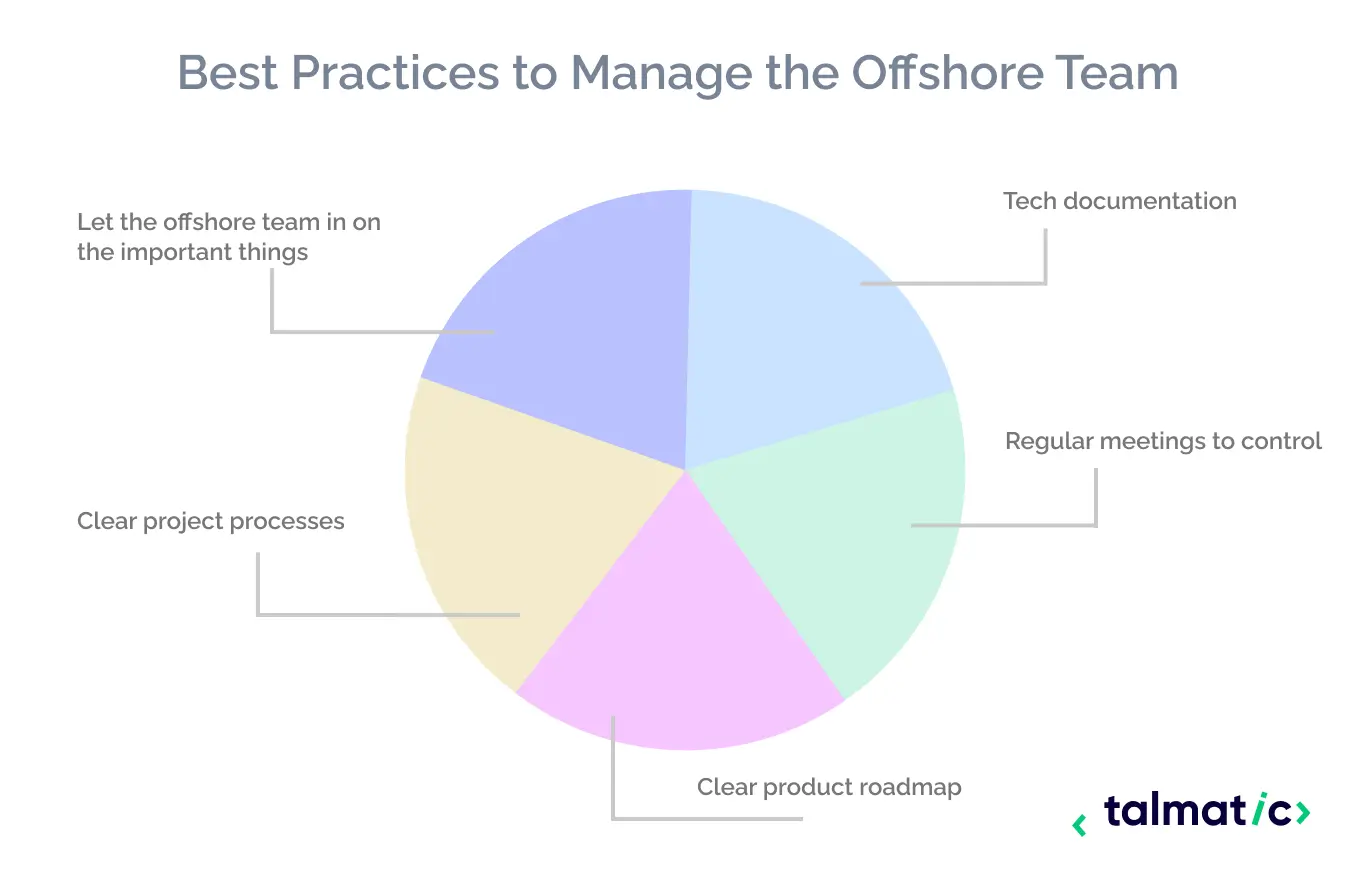Over the last two years, the unprecedented digital explosion heralded the need for more talented developers, leading to a rise in the engagement of dedicated offshore teams. According to the report by CompTIA, there were nearly 900,000 IT job postings in the first quarter of 2021. Firms in various parts of Europe sought to employ software developers from IT outstaffing services, cyber security experts, system & network administrators, web developers and python coders for hire.
So, we’ll explore the best practices in managing offshore development teams from a broader perspective and explain how you can deal with the surging talent shortage and other challenges. After this, you will be equipped to handle any situation or need that arises as you collaborate with people across the globe for the success of your projects.
Offshore employees are one of the most promising fixes to the rising development expenses, worker shortages, and the effects of the pandemic. An offshore development team is one that works on your project from another country without the need of being in your offices physically. For example, a client business operating from London can outsource the entire project to a better-resourced company in Ukraine or hire ukrainian programmers. Such an unconventional work set-up is a glimpse of what the future holds. However, though beneficial and highly favoured, it isn’t perfect just yet.
Faced with a 40 million skilled worker shortage, recruiters have found hiring developers on-demand is a complex task. Therefore, they have turned to offshore which has proved to be effective for many companies, whether they need to hire golang web developer or any other programmer. However, when collaborating with such teams, there are stumbling blocks to look out for. Here is a list of challenges that will help put your potential concerns into perspective:
A team could be located globally with a completely different time zone. If not adequately accounted for, this difference can work against monitoring, maintaining stable work schedules, and other management activities. For example, a client company located in Britain (a GMT zone) would require its group operating from Ukraine (an Eastern European Standard Time zone) to synchronise their watches to the British local time.
Language barriers lead to miscommunication. Developers must have a good command of the English language to ensure nothing is lost in translation or misunderstandings. With this in mind, many high-profile tech companies like Microsoft, Oracle, and Siemens have established R&D centres in Ukraine and Belarus where skilled professionals have a good command of English as an addition to their favoured attributes.
Effective communication is key to successful collaboration. However, not being able to have a face-to-face conversation lowers the effectiveness of your communication. Thankfully, some tools can bolster communication like Zoom, Microsoft Teams, and more.
Integrating a new group with an already existing one may take time since they might have different work cultures. For instance, a client company can emphasise consumer service as a major pillar for growth. In contrast, the outsourced company emphasises the quality of the product – the distinct views about what’s important and what’s not present cultural differences.
Even with these issues that might seem like serious drawbacks, most businesses opt to operate with this ever-evolving employment model as it produces great results. Importantly, they choose their destinations carefully, so countries like Ukraine naturally benefit the most by providing offshore teams.
Building an offshore team is not as easy as it sounds. There are loopholes only an experienced company can effectively manoeuvre. For more information about offshore teams, challenges related to building one, and how to hire full-time developer contact Talmatic today!
Pre-hiring managers are advised to consider several factors, including the company’s needs, budget, and project duration when hiring programmers online. These will determine who they can work with and in what format. The most popular types of groups to work with are:
Outsourcing is a general term for extended and dedicated teams that fill the client company’s in-house deficiencies. Generally, any third-party contracts for software development constitute an outsourcing model. An outsourced team is usually located far from the client company headquarters.
As the name suggests, the extended team is an actual extension of the existing in-house development team. The extended team is there to supplement skills that the main team lacks or help meet a tight deadline. Both the in-house and extended teams work in a closely-knit relationship geared towards the company’s goals.
A dedicated team usually encompasses a group of professionals in management, product development, testing, and anyone else who collaborate on a given project. Therefore, when startup companies do not need in-house developers on a full-time basis, they can contact a service provider that brings an entire team to work on the project.
A well-managed team of offshore programmers works like a well-oiled machine with excellent communication and teamwork at the centre of its operations. Although managers are overly improving, becoming close employee allies, there are some unsettling facts that make bad management practices worth looking into.
A recent survey by the Predictive Index found that:
That being said, here are a few management mistakes:
Micromanagement is a management style where the manager constantly monitors employees individually. That is considered bad practice because it takes away the employee’s freedom and replaces it with frustration, too much pressure, and general feelings of lack of trust, eventually crippling productivity.
Your in-house and offshore teams can collide, working under the same payroll. If not properly managed, a competition could instill hostility between the two teams, eventually resulting in a toxic working environment. This poor example of working culture is filled with unnecessary resentment, overwork (employees struggling to prove who is better than the other), and insecurity.
Both teams need to be on the same page where everyone’s efforts are synchronised towards the company’s objectives. This can be achieved by taking time to do proper onboarding and team building which some neglect as they do not consider the offshore team as part of their company.
Workplaces are not immune to difficult circumstances. Sometimes, breaking bad news to your employees or informing them of difficult issues is easier said than done. Good, effective leadership would employ simple, comprehensible correspondence channels to prevent miscommunication. In addition, transparency and the timely flow of adequate information should not be neglected either.
Top productivity, unparalleled products, expert services, and seamless collaboration are just some of the things you can achieve with offshoring. To get there, however, the best management practices need to be undertaken.
Remember, the external team is by your side. Sharing all your expectations, risks, and burdens with the development team is vital to achieving the best results. Always bear in mind the vitality of effective correspondence when hiring IT developers offshore. Share your company’s goals, mission, and objectives clearly and let your offshore partner work their part.
All development activities undergo a series of planning, initiating, controlling, and execution processes. Technologies like Jira exist for the sole purpose of operating a project, saving and tracking time, and overall operation oversight. These tools can be cross-linked across your teams and integrated with your company infrastructure to help manage the project process.
The product roadmap outlines essential information about your product. It defines your product, what it is meant to achieve for your customers, its features, and the problems it will solve. Simply put, a product roadmap outlines exactly what you are building.
Keeping constant touch with your external workforce helps identify and solve problems sooner than later. Make sure to schedule regular meetings to discuss any emerging issues and find solutions before moving on to the next stage. Frequent conventions also help control activities, receive on-time information, and boost commitment.
When everything is done, and your product is ready to launch, it’s time to piece it all together with the technical documentation. Tech documentation basically outlines all the information about your product: the functionality, the architecture, the user manual, and everything else your clients or in-house employees need to know.

In case you’re looking to hire an offshore development team, don’t go with anything less than the best trustworthy recruitment agency with access to a wide pool of talent.
At Talmatic, we have over a decade of experience providing unmatched offshore development teams. Contact our team today and build a custom team hassle-free.


No obligation to hire. No commitment from you.
Discover how Talmatic can help you solve your hiring headaches. In this personalized call, learn how we match you with developers that fit your technology and team needs.